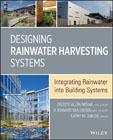
Designing Rainwater Harvesting Systems
AIA, LEED AP, Novak, Celeste Allen
ARCSA AP, Van Giesen, Eddie
PhD, DeBusk, Kathy M.
Water conservation is one of the most effective sustainable design practices, yet few professionals know how to collect and use rainwater effectively. Rainwater Harvesting the first comprehensive book on designing rainwater harvesting systems. It provides practical guidelines for developing a rainwater harvesting strategy, taking into account climate, public policies, environmental impact, and end uses. Case studies are included throughout. Rainwater Harvesting is a valuable reference for architects, landscape architects, and site engineers. INDICE: Chapter One The Importance of Rainwater Harvesting Water Capital A Brief History of Centralized Water Systems New Approach to Centralization – Decentralized Rainwater Systems Examples from Around the World India Germany The United States Policy Issues and Sustainability Water And Energy Savings Response To Drought Conditions Privatization and Relocation Valuing Water Resources History and Early Codes Source Value and Water Rates Return on Investment (ROI) Challenges, Education and Paradigm Shifts Stereotypes and Preconceptions Standards, Codes, etc. Water Quality PARADIGM SHIFT How To Read This Book: Chapter 2 System Planning and Policies Benefits That Drive Rainwater Harvesting Systems Planning A System Step 1: Identifying System Goals Site analysis Building Design and Programming Sustainability and Technology Step 2: Regulations, Codes and Standards Important Terms and The Big Picture Plumbing Codes Complex interactions between Regulations and Codes Stormwater Management Regulations A Short History of the Clean Water Act National Pollutant Discharge Elimination System (NPDES) Program Managing the Quantity of Stormwater Runoff Using Rainwater Harvesting Systems to Meet Stormwater Regulations Examples of Stormwater Management Programs that Incorporate Rainwater Harvesting Tysons Corner, Virginia State of North Carolina Step 3: Incentive Programs and Rating Systems Green Rating Systems Step 4: Educating and Involving the Stakeholders in the Design Process Step 5: Putting It All Together Chapter 3 Water For Thirsty Buildings Rainwater: Calculating Collection and Use Step One: Creating A Water Audit Step Two: Calculating Rainwater Supply Example: A. Collection Surface Area B. RAINFALL NOAA – Finding Annual and Monthly Data HOW TO USE YOUR RAINWATER DATA C. RUNOFF COEFFICIENT Step Three: Calculating Demand Examples: Building Sectors, Sizes and Demands SMALL OFFICE: Ann Arbor, Michigan Example: Schools in different climate regions HYPOTHETICAL EXAMPLE 1– School in Atlanta, Georgia COMPARING THE RESULTS – NORTH, SOUTH, EAST, WEST, SOUTHWEST SCHOOL RAINWATER COLLECTION SYSTEMS. Step Four: Cistern Sizing Alternative Water Sources Other Waste Water and Recirculated Water Plumbing Design and The Myth Of Unlimited Water Supply Thoughtful Planning Brings Success Chapter 4 System Elements Integrated Approach Opportunities for an Integrated Approach 1. COLLECTION/CATCHMENT SURFACE (Roof or other) 2. CONVEYANCE (GUTTERS AND DOWNSPOUTS) Dry Conveyance and Wet Conveyance Sizing and Numbers Aesthetics/Functions/Budget Conveyance Aesthetics Conveyance Functions Conveyance Budget 3. PRE–STORAGE FILTRATION / DEBRIS EXCLUSION PRE–STORAGE FILTER TYPES AND APPLICATIONS Downspout Filters Centrifugal Filters Cascading Debris Excluders Other Pre–Storage Filtration Devices MERGING THE GOALS OF RAINWATER AND STORMWATER 4. STORAGE ABOVE GROUND TANKS Summary of Recommendations For Above Ground Storage Tanks BELOW GROUND TANKS Typical Materials For Below Ground Tanks Recommendations For Below Ground Storage FACTORS TO CONSIDER 5–DISTRIBUTION Integration, Thoughtful Planning and Continuing Education Are The Keys To Success Chapter 5: Maintenance and Safety Water Quality of a Rainwater System Sources of Pollutants Fate and Transport of Pollutants in a Rainwater Harvesting System Microbial Contamination Addressing Water Quality for Various End Uses First Flush Water Testing Protocols Utilizing a Back–Up Water Supply Methods of Back–Up Maintenance Considerations Case Studies – Cautionary Tales and Pilot Projects for Potable Water Systems Summary of Design Recommendations Conclusion Chapter 6: 21 st Century Interviews Billy Kniffen Dennis Lye Ph.D. Chapter 7: Case Studies Appendix A Appendix B Appendix C Appendix D
- ISBN: 978-1-118-41047-9
- Editorial: John Wiley & Sons
- Encuadernacion: Cartoné
- Páginas: 384
- Fecha Publicación: 30/04/2014
- Nº Volúmenes: 1
- Idioma: Inglés
